#era axial
Explore tagged Tumblr posts
Text

«Si hubiera un eje de la historia universal habría que encontrarlo empíricamente como un hecho que, como tal, valiera para todos los hombres, incluso los cristianos. Este eje estaría allí donde ha germinado lo que desde entonces el hombre puede ser, allí donde ha surgido la fuerza fecunda más potente de transformación y configuración del ser humano de tal manera que pudiera ser convincente, sin el apoyo de una determinada fe, para el Occidente y Asia y en general para todos los hombres. No se necesitaría que fuera empíricamente concluyente y palpable; bastaría que tuviera por base una intuición empírica en forma que ofreciera un marco común de evidencia histórica para todos los pueblos. Este eje de la historia universal parece estar situado hacia el año 500 antes de Jesucristo, en el proceso espiritual acontecido entre los años 800 y 200. Allí está el corte más profundo de la historia. Allí tiene su origen el hombre con el que vivimos hasta hoy. A esta época la llamaremos en abreviatura el “tiempo-eje”».
Karl Jaspers: Origen y meta de la historia, págs. 19-20. Alianza Editorial. Madrid, 1980
TGO
@bocadosdefilosofia
@dies-irae-1
#tiempo-eje#jaspers#karl jaspers#origen y meta de la historia#fe#occidente#asia#historia#historia universal#empiria#existencialismo#era axial#teo gómez otero
3 notes
·
View notes
Photo

Eratosthenes of Cyrene
He is best known for being the first person known to calculate the circumference of the Earth, which he did by using the extensive survey results he could access in his role at the Library; his calculation was remarkably accurate.��He was also the first to calculate Earth's axial tilt, which has also proved to have remarkable accuracy. He created the first global projection of the world, incorporating parallels and meridians based on the available geographic knowledge of his era..
Read more: https://en.wikipedia.org/wiki/Eratosthenes
#Eratosthenes#ancient greece#ancient history#history#greece#geography#maps#earth science#Earth#science
1K notes
·
View notes
Text
SPARKLECARE THEORY DOES SPINCH ROTATE WESTWARD?

Spinch's axial tilt may be just like Earth's, but it seems like it doesn't rotate like our planet does.
Earth rotates eastward which makes us observe the Sun rising in the morning by the east and setting at evening by the west. The time zone that is set west off yours will see a specific time on the clock after you do and the one that is set to the east of yours will see it before you.
Time zones have become more relevant in this era where one can befriend more easily than even before people that live on countries that are even on a whole different continent away from you; which creates interesting situtations always.
For example, an European gets to congratulate the birthday of someone living in the Americas before such person can even do it, because Europe is eastern respective to them and the date on the calendar will switch early for the European in real time.
Does that remind you of something?


That's right! Carl gets to say happy hatchday to Sly earlier than her own family because Palentine's time zone is set nine hours earlier than the one of Moorening; it's still ten minutes before midnight for Sly but it's 8:50 already in the Runday morning for the dragon boyfriend.
So that means LCL is eastern off CLC, right? Well !


You have two choices here to explain this:
Spinch is round and has no edges, the International Date Line well could run across the Menne sea through Efusekay. Think about how Japan maps are centered to the Pacific Ocean and that leaves Japan in the left and the Americas in the right. And Japan still has its time zone earlier than the Americas.
Palentine can be more western than East Eroid and still have a time zone set earlier than them because Spinch rotates in the opposite direction Earth does: a.k.a. westward. This would also make the Son rise in the west and set in the east. It is implied than the International Date Line runs through the Bitch sea then. Venus is the only planet in the Solar System that rotates in the opposite derection respective to the other planets, Spinch would be a similar case.
17 notes
·
View notes
Text


The dream for this arts community is a good one, the motives fairly sincere and honorable. If those hopes, fantasies and aspirations are not realized, the failure stems more from the reluctance to face certain critical realities early enough than from the concept itself. And the most significant of these realities concerns the physical milieu—the sort of locale and assumptions that the architectural solution required.
Purchase thus becomes an architecturally compressed metaphor for conflicting attitudes about a physical environment and how it is created. The campus design reveals most of the pitfalls of creating, from scratch, an architectural embodiment of cultural aspirations; it also reflects certain intriguing contradictions. For behind Purchase is a paradox: The college emblemizes a set of architectural values in the vanguard of the years (around 1965) when it was designed. These values—reliance on vernacular forms, antimonumentality, historic continuity, sense of place, and variety or surprise—were previously forgotten principles that dominate architectural attitudes today. Yet Purchase reveals the antitheses to this set of values, in some cases in undiluted strength.
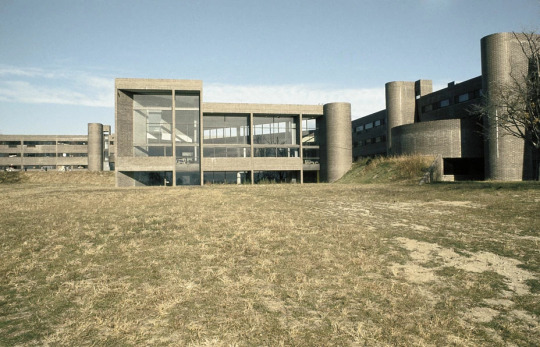
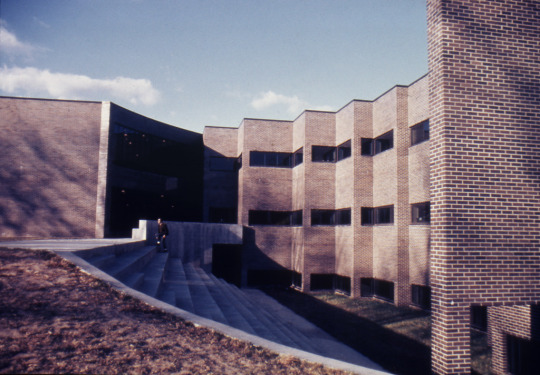
At a glance, the plan is unabashedly Beaux-Arts. Its strong longitudinal axis, the mall, with the streets running on cross axis to it, the placement of a performing arts center at the top, a gymnasium (is that symbolic?) at the bottom, all create a definite symmetry and organization of some bygone era. From a modern architect known for his adherence to quiet unassertive forms, his Harvard training under Walter Gropius and Marcel Breuer, this overriding axiality of Barnes’s plan and the grandly proportioned open spaces may come as a surprise. Nevertheless, modern architects have given in to their secret Beaux-Arts fantasies before. While considered an aberration since the modern movement substituted shifting balances for symmetry (among other things) as the chief means of ordering design, various forms of classicism and neo-Palladianism have made repeated forays onto the architectural scene. One could read the tendency in the work of Mies van der Rohe, see it full-fledged in Philip Johnson’s architecture of the 1950s, and of course always find it somewhere in the work of Louis Kahn. Even urban-planning thinking has often been (consciously or not) Beaux-Arts-oriented. As Vincent Scully recently remarked, while the Beaux Arts suffered much unpopularity in the ’40s, by the ’50s architects visiting Europe began to “discover that Beaux-Arts streets and squares made sense urbanistically.”
Barnes himself was not immune to them. A classicizing order began appearing in his houses, then gradually seeped into campus schemes in the ’50s and ’60s. So it is not unusual that Barnes should “return” to those preoccupations to create the highly dense urban situation at Purchase. He had never really gotten away from it—and neither had many of his other colleagues in the modern movement. The important question here, however, is why bringing back the Beaux Arts fails to work at Purchase. If Paris was the city of expansive vistas and grand boulevards in the 19th century, a “phantasmagoria of space to which the flaneur was addicted,” as Walter Benjamin noted, Purchase’s pedestrians seem less than ecstatic.
15 notes
·
View notes
Text
@msexcelfractal
Would you consider global colonialism and climate destruction to be huge qol improvements? Industrial humanity has knowledge without wisdom and it’s going to destroy us - the ttc remains a relevant warning
i think this is a great example of not being able to even begin to take a long historical view on anything. obviously the philosophers of the warring states era of chinese history whose work was compiled into the tao te ching had not even the foggiest notion of "colonialism" as the concept is used in modern political discourse or of climate change! how could a work of axial age political philosophy, when the global population was measured in the low hundreds of millions, have anything thoughtful or interesting to say about climate change, a consequence of technological and social processes that wouldn't begin for another ~2,000 years?
the only way the tao te ching can have any relevance to the present day is if we renegotiate the text--this is something dan mcclellan talks about a lot in the context of religion; it's basically an automatic process. we have texts that are culturally significant to us, which remain important for reasons of identity, and which we thus must find ways to keep relevant, bc we're unwilling to abandon them; thus, even as the politicial/social/technological/cultural/etc. context around those texts changes, even changes very radically, we must find new ways of reading those texts in order to keep them relevant, so that we don't have to abandon them.
not only is it historically baseless, i think it indicates a profound lack of imagination and a profound inability to do the kind of thoughtful, sympathetic reasoning necessary to really appreciate texts from other cultural contexts to look at something like the tao te ching and only be able to read into it modern concerns. to, in other words, draft every ancient text you read as a soldier in modern arguments. the concerns of the author(s) of the tao te ching were completely different from yours! like, maybe if you're a committed taoist interested primarily in devotional readings of the tao te ching there's something there you can work with, but even then i think that's kind of fraught--like, i don't think Christian readings of Isaiah are on much better footing even if they admit, sure, yeah, Isaiah really has nothing to do with Christian notions of the messiah. I think you're still doing something silly there, and even if you acknowledge you're bending the text out of shape on purpose it's more interesting in its original sitz im leben.
and really--what lessons could we drag out of the tao te ching even if we dragooned it into a modern context? break the world up into sovereign states so small that the people of one state can hear dogs barking in the next state over, but will grow old and die without having had any dealings with them? how can we operationalize the dictum that governing a state is like boiling a small fish? the tao te ching is a fascinating and thoughtful book, and totally worth taking seriously--but it's not a modern work of economics or political science! and the work necessary to turn it into one would constitute constructing a whole new political philosophy that has nothing to do with the actual text and everything to do with the preexisting beliefs of the person doing the constructing. you, presumably, would build some kind of generic leftist philosophy out of it. someone else might discover it's really a tract about right-libertarianism. somebody else might decide, well, really it's about RETVRNing to some kind of ultra-authoritarian hyper-patriarchal micro-feudalism.
like, not to be a huge bitch or anything, but... be serious. think outside the extremely narrow context of contemporary political horizons for five freaking minutes.
#governing a state is like boiling a small fish#because both are ruined by being handled too much#(according to the notes of the very excellent DC Lau translation i own)
43 notes
·
View notes
Text
Vibin’ with Secret History where Kelsier sees GREEN plants and is momentarily stunned.
Like he’s scaling this wall, and as he does so he feels this planet. It’s Sel, but he doesn’t know that, and green being a plant color is so utterly alien to him he’s intrigued and stunned.
Scadrial is so utterly fucked up. Even Roshar, with it’s insane weather patterns and lack of an axial tilt has green plants. Green is the color of chlorophyll. It’s associated with life, hence life spren on Roshar being little green motes. Scadrial in the first era was just red and black. What a miserable place to live. Mare collected pre-ascension lore. She knew it wasn’t the way things should be, and Kelsier was determined to bring it back. What’s more, he succeeded by aiding Fuzz, Vin, Elend and the rest. He brought back Mare’s world.
Brown plants exist. Specifically, the shades in the final empire are possible, but these plants are adapted to low light levels.

This tradescantia is native to the southern US. It loves direct, baking sunlight, and thus uses anthocyanins to color it’s leaves to be able to tolerate the baking heat.

In the water light is refracted and reflected in such a way that light cannot penetrate, and plants have had to adapt. These aren’t truly plants; they’re a type of algae. This is Kelp. You’ll find a lot of colored plants below the water.
30 notes
·
View notes
Note
M-12 Sabretooth from Resistance: Fall of Man?
You know, the closest I ever came to playing that game was an ARMA 3 Halloween operation.
Anyways, The M-12 Sabertooth

Aliens are invading Earth again, and this time they're coming hot on the heels of WWII.
So, this chassis has some pretty clear inspiration from the M1 Abrams; Running gear, side-skirts, mud-guards, even the front of the hull bear similarities to some extent.

Engine Deck is a mix of Leopard 2 fans, M60 rear grill, and even the air filters from early model Tiger 1's. Turret draws lineage from British Centurions (notably the Mk1 prototype which mounted a co-axial 20mm auto-cannon) and the add-on armor on the turret brings to mind a T-80 with ERA fitted.
This is apparently a "Light Battle Tank" so its mobility should be decent. Those road-wheels are packed in there pretty tightly.
Its also light enough to be air transported, so armor won't be stellar by any measure, but it should be sturdy enough. It's also equipped with so form of add-on armor on the turret, whether its just applique panels or ERA is unknown to me.
The Sabertooth does have some pretty sharp teeth, an 80mm rifled main gun, a .50 cal MG for the commanders hatch, and a 20mm Gatling gun mounted co-axially. That last one is a bit of an odd choice. Now, there have been a few semi-modern tanks that mounted an auto-cannon co-axially in the turret, notably the French AMX-30. But nothing to my knowledge ever mounted any caliber of Gatling gun in the turret. The main issues with this concept is space inside the turret. Its already at a premium with the main gun, armor, crew and ammunition in there; adding a bulky Gatling gun instead a normal auto-cannon is redundant since its fire-rate is probably going to be limited to below 1000 rpm so it doesn't chew through all its ammo in 6 1/2 seconds. And if that's the case, you're better off space wise going with a normal auto-cannon.
I'm not seeing very many viewports on this, or maybe they're just really small. We do atleast get a spotlight.
Driver's hatch in the hull and the commander+gunner's hatches in the turret lead me to believe it has a crew complement of 3-4.
And we have a fair array of stowage, maintenance hatches, panels, headlights and tow hooks.
FINAL SCORES
Credibility: 6/10 - r/NonCredibleDefence Approved
Coolness: 6/10 - Forest MultiCam
BONUS
Some nice AMX-30 Footage
youtube
5 notes
·
View notes
Text
VIK 10.08.3343 IE NH // TUE 12.05.2023 CE GD
It appears I was wrong on *several* levels regarding the nature of my innerworld, as well as my kintype.[1]
After much reflection, our innerworld’s genres appear to be (1) mythic historical iyashikei (albeit with Brothers Grimmesque folkloric / psychological horror elements), and (2) Arcadian Filianic media.
Similar works include “Spice and Wolf” by Isuna Hasekura, “Violet Evergarden” by Kana Akatsuki, “Little Goody Two Shoes” by AstralShift & Square Enix — *MAJOR* vibes with LGTS, by the way — and *especially* “Aristasia” by The Aristasia Community.
I (Yashi) appear to be a vixen spirit (one of the local minor geniae, to use a Filianic term) very similar to Holo from “Spice and Wolf”. We (the Orchards) are ALL spirits, as far as we know (there’s five of us). [2]
Rhiannë (aka Kyria, our godshard of Dea Filia) is a horsegirl (like those in “Uma Musume Pretty Derby” by Cygames) as opposed to a centaur, because… that’s just easier to visualize, I guess. Yasumi (if that’s still her name) is a local minor folk janya of healing. Sophie’s an attendant of Sai Candrë, which is a mythological pun — she’s an insomniac rabbitgirl, and in Japanese folklore, the moon (Sai Candrë’s sphere)’s associated with rabbits. This would also explain why Sophie looks so tired all the time: because her job requires her to work at night, yet she (Sophie) still interacts with the rest of the Orchards during daylight hours! Blueberry might be of the shiani (Filianic fae), but I’m still not quite sure. I’ll have to make it a point to ask her sooner or later.
Roughly 99% of other maids only see us Orchards as everyday Axials (ie “typical” intemorphs, of which, in this particular innerworld, there’s a bare minimum of *seven* feminine types — each based upon one or more of the myriad janyatic principles). [3] That said, this kinda-sorta works similar to Amaterasu’s divine markings in “Ōkami” by Clover Studio & Capcom — we (the Orchards) can see one another’s true forms, but most maids who aren’t spirit-beings or spiritually attuned can’t see our animal ears, tails, wings, etc.
The main area of the innerworld is Saresgrove. In older English, “sare” means “withered, rotten, dry, melancholy, etc”. Thus, “Saresgrove” more or less means “a sort of gloomy, withered wooded area”.
There are monsters of the week in the form of keres (Filianic demons) such as Anxietas, Dysphoria, etc. There’s a nearby wooded area called the Deepwoods (which is safe(ish?) for exploration), and then there’s the *Deeperwoods* (which is where all the eldritch horrors and monsters of the week lurk in the dark).
Overall, the historical era appears to be some kind of anachronism stew between c. 1400 and 1910 CE GD.
No magic in Saresgrove — Saresgrove’s very similar to the not!Europe of “Spice and Wolf” in this regard. That said, doors exist between media-worlds in the form of a phenomenon known as Sai Brighë’s Door.
〜 〜 〜 〜 〜 〜 〜 〜 〜 〜 〜 〜 〜
[1] …Now that I think of it, I might’ve been right on both kintypes all along — I’m a vixen genia, yes, but I’m *also* from an all-girl world (and, thus, an alien).
[2] That is to say, there’s five of us *for now* (as of SUC 10.25.3343 IE NH // FRI 12.22.2023 CE GD).
[3] We’d like to clarify that, while Saresgrove seems to be some form of protectorate / territory / etc. of the Queendom of Arcadia in Internalia, schizomorphs (i.e. beings from not-all-female worlds) are more than welcome. For instance, Kyria Rhiannë seems to have greenlighted Flocke [LGTS] for entry to Saresgrove, if / when we find out what happens in Kieferberg. Additionally, there’s at least *one* anthropomorph.
5 notes
·
View notes
Text
Ensayo de Tema 2. Medici: Masters of Florence (2016)
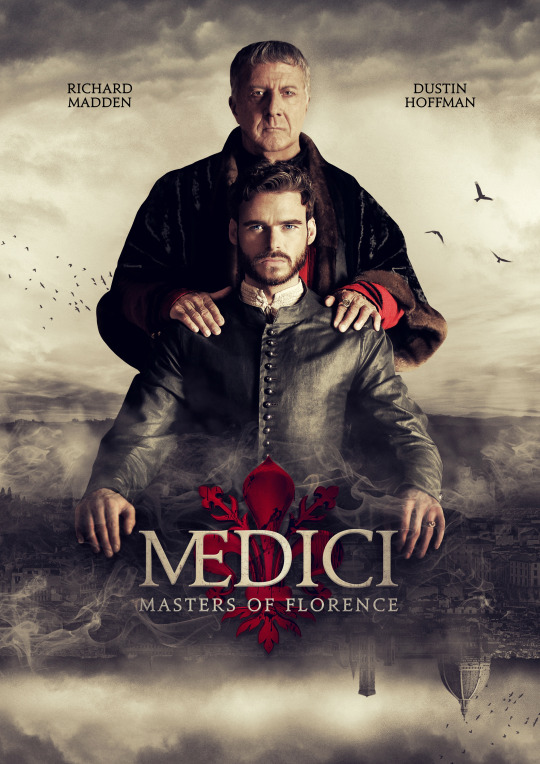
La serie de televisión Medici: Masters of Florence es un drama histórico basado en la familia Medici de la Florencia del siglo XV, en los inicios y auge del movimiento renacentista.
Desde un punto de vista cultural, la serie ha tomado sus libertades con respecto a la precisión histórica. Sin embargo, narrativamente, ha podido acercar a la familia Medici y el Renacimiento italiano a una audiencia moderna tomando en cuenta rasgos o puntos claves de contextualización histórica. La serie destaca la importancia de la arquitectura en el ascenso al poder de la familia Medici, ya que fueron mecenas de las artes, donde sus encargos no sólo tenían propósitos de afición o contemplación, sino pensados para fines políticos, sociales y econ��micos.
En el inicio de la serie, se muestra como la familia Medici tuvo sus comienzos en la industia del comercio de la lana hasta convertirse en uno de los bancos más grandes de Europa (con conexiones poderosas sobre todo en la zona occidental del continente), logrando un alto status social y político. Tomando en cuenta los crecientes juegos de poder en el contexto de ciudades-estados dominadas por la nobleza, los Medici alcanzan ese privilegio por medio del desarrollo de su industria banquera desde el cimiento.
A lo largo de esta primera temporada, se muestra uno de los principios fundamentales de la familia Medici: la percepción es poder, y la arquitectura juega un rol fundamental para dicha percepción social y política.

Cosimo, el heredero de la familia luego de la muerte de su padre Giovanni, era un hombre idealista con un pasado en las artes. En el contexto de la muerte de su progenitor y de la guerra de Milán y Florencia, él utiliza la arquitectura como su medio principal para consolidar la influencia y poder de su familia en la ciudad, teniendo la opinión pública a su favor. Esto lo logra con la construcción del domo de la Cattedrale di Santa Maria del Fiore, la catedral de Florencia que tenía décadas paralizada en su construcción, debido a la alta dificultad (o casi imposibilidad en la época) de terminar la cúpula de grandes dimensiones (mayores que las del Panteón romano).

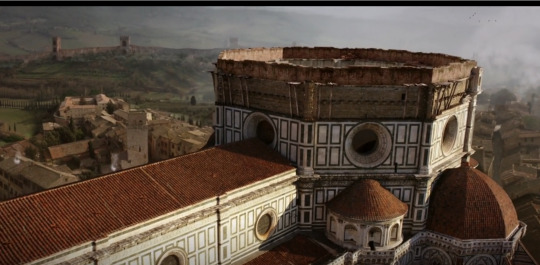



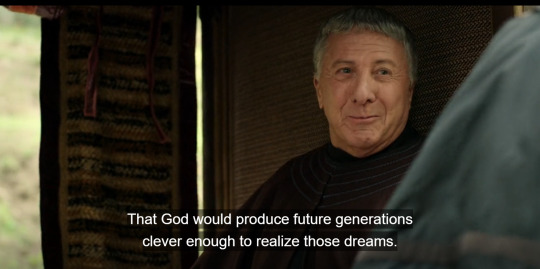
En el aspecto contextual artístico, se pueden observar los fondos de las escenas ricos en estilo y estética, resaltando los rasgos paleocristianos, románicos y góticos tardíos transicionando a nuevas formas durante el Renacimiento.
Desde los frescos basados en el antiguo estilo romano (usado exhaustivamente en el arte paleocristiano), las columnas de órdenes griegos que brindan simetría axial y orden, las catedrales de planta de cruz latina, hasta los palacios de patio central y cortile, la serie se encarga de exponer y pasear a la audiencia cinematográficamente por todos los elementos que componían el panorama artístico y arquitectónico durante el Renacimiento, donde el presente estaba en constante diálogo con el pasado.

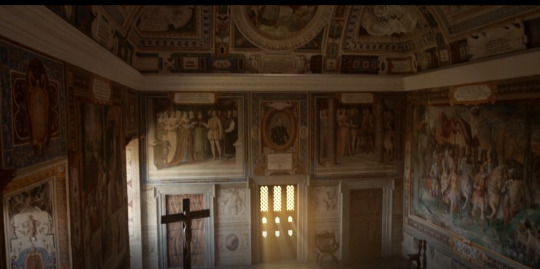
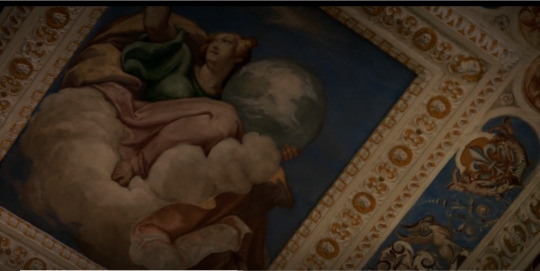

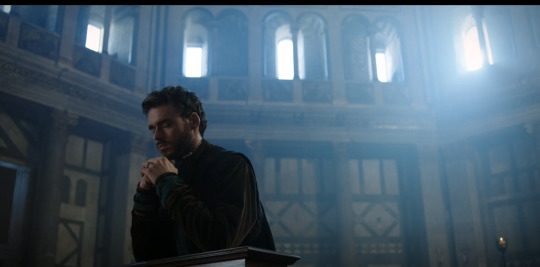
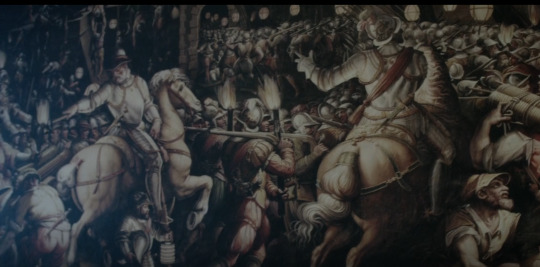
Se resalta el debate dicotómico que se estaba produciendo vivamente durante la época entre el pensamiento predominante del medioevo sobre la guerra como medio de superviviencia, y el nuevo pensamiento de cuestionar los órdenes establecidos y los métodos de resolución de conflictos para los intereses propios. Se destaca reiteradamente que siempre se puede tomar una decisión de seguir con las antiguas tradiciones disfuncionales, o aventuararse a una filosofía que permita una mejor sociedad y existencia para uno mismo, incluso en la estrechez de la situación. Esta idea también se representa a lo largo de la serie entre los métodos de Giovanni como patriarca de la familia y los métodos de Cosimo como heredero (buscando tomar libertades que no eran usuales en los manejos políticos del padre).
Continuando con el desarrollo en el segundo y tercer episodio, la guerra con Milán no estaba dando buenos resultados y la economía de Florencia estaba en ruinas (impuestos altos, escasez de flujo de dinero, cierre a importaciones, destrucción de la base de empleo e inversión, etc.). Cosimo financia al visionario orfebre y arquitecto Filippo Brunelleschi para que construya una cúpula para la catedral de Santa Maria del Fiore, generando así empleo y migración interna, mientras los Albizzi seguían explotando a la población con miras de seguir manteniendo el estado de guerra, por lo que Cosimo negocia un acuerdo entre Lucca y el duque de Milán para la paz por medio de su contacto, Francesco Sforza.
Se resalta como Cosimo se volvió un estatega político y económico tanto de sus recursos como de los recursos disponibles de aquellos a su alrededor, con tal de lograr sus intereses y objetivos sin ensunciarse las manos en el acto, siempre y cuando beneficie la imagen de la familia Medici. En la serie en general, se ve cómo los poderosos utilizan a la población civil y su fervor/lealtad religiosa o política para sus propios intereses.

En cuanto a la construcción del domo de la catedral, Filippo Brunelleschi fue contratado para la obra. Se presenta como él, en un principio, no era considerado en su círculo social debido a sus actividades de orfebre. Sin embargo, Brunelleschi es presentado en la serie como el visionario que fue, ideando un diseño basado en el cálculo matemático estructural para poder construir la cúpula.
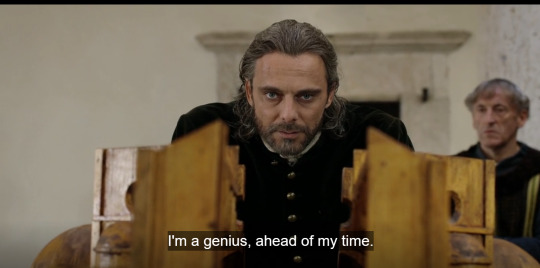
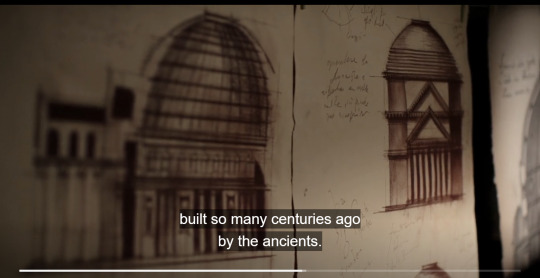

Explica que se realizará sin sistema de andamiaje; en cambio, será construida en el aire, siendo sostenida por dos domos en vez de uno. El domo interior funcionará como soporte para el domo exterior. Los primeros 46 pies serían construidos en piedra, luego se utilizarían materiales más livianos, como por ejemplo el bloque de ladrillo, el cual sería colocado en forma de enlosado en espina de pez (conocido como herringbone pattern en inglés), de manera que los bloques sirvan de soporte unos a otros.
Como buen renacentista, se basó en los principios clásicos de orden, centralidad y distribución de peso encontrados específicamente en el Panteón de Roma, el cual sería su "musa" para esta obra.

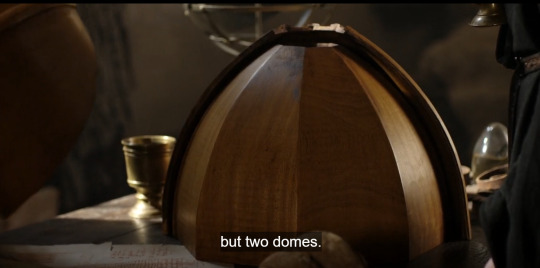

Estas situaciones que se han descrito hasta ahora revelan que una de las nociones fundamentales de Cosimo durante la serie para cumplir sus objetivos es el de aprovechar (o ingeniar) oportunidades en los escenarios complicados o precarios. En estos episodios, la arquitectura fue protagonista de su jugada económica, política y social para dar propaganda a su familia, generar empleo (y, por ende, ingresos) para la ciudad con la construcción del domo de la catedral, dar una peor imagen a la guerra de la que ya tenía entre la opinión pública florentina, llevando a perjudicar indirectamente a su rival, Rinaldo Albizzi. Además, Cosimo utlizó los fondos de los diezmos de los fieles religosos destinados al papa para la elaboración de la construcción, justificando incluso los fines religiosos de tal emprendimiento.
Durante la peste negra, se incentivó a continuar la obra, esta vez convirtiendo a la catedral en un hospicio para los víctimas de la peste, una vez más, favoreciendo la imagen de los Medici ante la opinión pública.
Con esta estrategia magna de Cosimo, la gente no estaría agradecida con los Albizzi por hacer la guerra o incentivar levantamientos políticos que generan inestabilidad social, sino con los Medici por haber alimentado a sus familias y desarrollado la economía en tiempos de crisis, fortaleciendo el favor de la población, el cual, guiándose por los principios de "El Príncipe" de Maquiavelo en los capítulos 2 y 3 (Nicolás Maquiavelo, "El Príncipe". 1532, Italia), es fundamental para mantenerse en el poder y lograr control sobre ellos por medio de su propia voluntad.
Continuando con la línea de pensamiento maquiavélica, es bueno para el gobernante ideal ser amado por su población por los actos que hace para manternerla contenta, y, al mismo tiempo, es bueno ser temido por esa misma población cuando se muestra lo que ocurre si alguien busca alterar el orden y el poder del gobernante. Desde mi punto de vista personal, esas nociones de teoría socio-política/ciencias políticas están bien logradas en la serie.
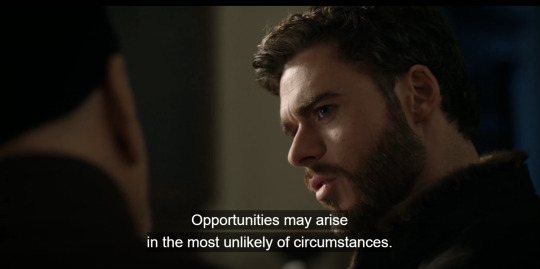
En cuanto al contexto religioso, se reflejan las prácticas comunes de la iglesia de la época, donde la curia católico-romana del periodo renacentista no se caracterizaba precisamente por ser "fieles religiosos movidos por la fe". Parafraseando al teólogo argentino Lucas Magnin (Magnin, L., "Las Cinco Solas: ¿Por qué nunca me contaron esto?"), era un tiempo donde el continente pasó de ser de papas y pontífices a príncipes. El papa y el alto clero tenían mayor interés en ser mecenas (y la percepción y beneficio social que ello conlleva) que ser pastores. Era un tiempo donde ser papa o cardenal daba un estatus y poder cercanos (o, incluso, hasta igual o mayor) al de un príncipe o gobernante de la nobleza. Mientras más conexiones (y capital) hubiese para subir la intrincada escalera jerárquica de la iglesia de ese tiempo, mejor, puesto que aquellos que se introducían a las altas esferas del clero veían realizadas sus expectativas de riqueza.
De acuerdo a los testimonios de la época de creyentes descontentos con la institución (como Pedro Valdo, Girolamo Savonarola, Jan Hus, John Wycliffe, William Tyndale o el propio Martín Lutero con sus 95 tesis), las intenciones de estas personas en el establishment religioso eran dejar huellas de poder de la mano de las grandes mentes artísticas e intelectuales del Renacimiento; los sacerdotes de las parroquias que buscaban guiar genuinamente en la fe a los feligreses contaban con muy poca instrucción teológica, pastoral y filosófica, sin contar con el apoyo necesario de la institución.
Esta era la cristiandad que se estaba viviendo, donde ser cristiano era más un asunto cultural que uno de convicción, situación que empezaría a ver su ocaso desde el Renacimiento en la sociedad europea gracias al auge la modernidad, llegando a lo que hoy en día en el Occidente posmoderno se conoce como post-cristianismo.
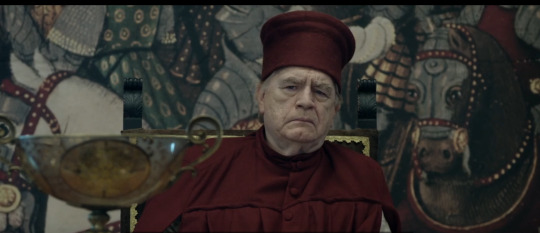

Todo este contexto religioso que se muestra en la serie de Medici: Masters of Florence es lo que sentaría las bases posteriormente para la Reforma protestante.
En conclusión, la serie no es un recuento histórico exacto (lo cual no es el objetivo principal, no es lo que busca la serie, ni debe ser la expectativa de uno mismo como espectador), sino una aproximación y representación histórica adaptada para una audiencia moderna, donde la contextualización, estilos y narrativa está bien lograda. Desde la escenografía, la actuación, el reparto y el guión hasta el desarrollo de la trama y la concientización de la audiencia sobre las situaciones de la época, en general, son elementos que logran su cometido en acercar a los espectadores al contexto renacentista, la crisis ideológica de transición que se estaba viviendo y del uso de la arquitectura y las artes para la consolidación del poder e influencia, por medio de una de las familias que tuvo mejor uso de esos recursos cuando se presentó la oportunidad: los Medici.
#lonuevodenuevo#arquitectura#architecture#historia#historia2#renaissance#renacimiento#cultura#medici#cosimo de medici#filippo brunelleschi#italia#firenze#essay
2 notes
·
View notes
Text


13 October 2023
I had my first "Celebration of Knowledge" (exam) today! I felt good about it until I got to a spot where I had to find the square of something -- I thought "uh-oh. I don't think I memorized the equation correctly because there's no calculators and I have to square a number" -- but then I heard some calculator clicking buttons and took a big sigh of relief. I didn't have a calculator, so I had to multiply it by hand :')
The pic on the right is of my "Quizlet streak" that I didn't know was a thing. I've been trying to study bones at least 30 minutes a day. I finished memorizing the appendicular skeleton, now it's time for the axial skeleton!
Happy Era's Tour Concert Movie release day to all that celebrate!
Now listening to: Miss Americana and the Heartbreak Prince
#studyspo#studyblr#pharmblr#a&p#anatomy and physiology#quizlet#taylurking#taylor swift#eras tour#swv#swv:oc#studywithvictory#Spotify
5 notes
·
View notes
Note
question though:
If the Christian God is real what does that make you think of the Bible
a pretty solid collection of those of his doings which spoke to the Jewish people during the Hellenistic period, a new age of marvels very like our own
i have this very strong feeling of there being a 500 year long "present time" in antiquity as being pretty much the period between the Transmigration to Babylon and the end of the Apostolic Age. I think this is informed mostly by it being Bible Times, rather than any sort of Axial Age of Axial Virtue. The most presentlike feeling I have is in the Augustan era, and I am convinced by Crossan that his absence makes him among the most conspicuous characters in the New Testament.
9 notes
·
View notes
Text
Top 5 Vintage-Inspired Watches
Explore the top 5 vintage-inspired watches that combine classic designs with modern functionality.
Vintage-inspired watches have an undeniable charm. They combine the elegance of bygone eras with the reliability of modern watchmaking. These timepieces evoke nostalgia while offering contemporary features, making them extremely desirable to fans and collectors. This guide delves into the top 5 vintage-inspired watches that beautifully blend the past with the present.
Why Choose Vintage-Inspired Watches?
Timeless Appeal: Vintage designs always stay in style, offering a classic look that remains elegant through the ages.
Modern Reliability: While the aesthetics are retro, the movements and materials are up-to-date, ensuring precise timekeeping and durability.
Unique Character: Vintage-inspired watches often feature distinctive details that set them apart from contemporary designs, adding a touch of individuality to your collection.
Top 5 Vintage-Inspired Watches for 2024
1. Omega Seamaster 300:
The Omega Seamaster 300 pays homage to the original model from the 1950s. This reissue combines the classic design elements of the vintage model with modern advancements. This watch features a black dial, vintage-style hands, and a stainless steel case, which makes it elegant and robust. Its Co-Axial Master Chronometer movement ensures exceptional precision and durability.


3. TAG Heuer Autavia:

4. Tudor Black Bay Fifty-Eight:

5. Seiko Prospex SPB143:
Seiko's Prospex SPB143 draws inspiration from the brand's first-ever dive watch, released in 1965. This modern interpretation features a 40.5mm stainless steel case, a black dial with vintage-style markers, and a date display. Its automatic movement and 200 meters of water resistance make it practical for everyday wear and diving adventures.

Conclusion
Vintage-inspired watches offer the best of both worlds: the ageless beauty of traditional designs and the reliability of modern technology. The five watches highlighted here are perfect examples of how contemporary watchmaking can celebrate the past while providing the quality and precision expected today. Whether you're a seasoned collector or new to the world of watches, these vintage-inspired models will surely provide a classy touch to your collection.
Source: Vintage-Inspired Watches
0 notes
Text
Bret Devereaux pointed out in one of his recent posts that, while the model was slightly different, the republican Roman constitution was still, basically, the constitution of a city, not an empire. Not a particularly big city, either Ergo, everything had to be done in person. Ergo, terms of one year. Etc. And that seems important to me to understand why, even if Graeber and Wengrow are right and there was a huge diversity of modes of social and political organization in humanity's distant past, why axial age states frequently converged on some kind of despotism as they got bit. There is a problem of scale here, which is related to the issue of bureaucracy and communications.
I mean, also one of basic politics: why do the people of Smyrna want to be part of a larger empire, whether Greek or Roman or Persian? They probably don't depend enough on trade in that era to make the early modern model of large states as basically common trade areas useful to them. Local elites would prefer to retain all of the excess they can capture rather than sharing it with a distant king. And the local peasants aren't too keen on taxes going up. So the only people interested in building large states are empires, whose elites want to increase the amount of wealth they have, and conquest is cheaper (and much more productive, by huge margins) than local investment.
(Small states occasionally form as confederations against larger foes--this seems to be how the Northern Kingdom of Israel formed, as a confederation of tribes in the hill country trying to oppose outside conquest. But these confederations are limited by the extent of common cultural and political interests; they may transition later into empire-building states, though.)
So if you want to build a big state in the axial age, the number of models you have to look to for how to do it is going to be pretty limited. And you're probably not going to converge on anything like democracy, even for regional elites, because you don't want people democratically deciding to dissolve the empire. That's not what empires are for. But even accounting for that, the Roman model seems really deeply unsuited for that the Romans were trying to do in the last couple centuries BCE. Rome was getting too big, Italian politics were too complex, and the early imperial conquests were on too large a scale to run a burgeoning empire on city-state institutions. And idk, maybe everybody was too jealous of their slice of the power pie, of their particular relationships of patronage and authority, to consider yielding any of that to a formal bureaucracy. But instead they got an Emperor, and an awkward system of succession prone to crisis and civil war!
39 notes
·
View notes
Text
Dr. Etienne Archambault: Vintage vs. Modern Watches – Which Reflects Your Personality

In the world of horology, Newfoundland's Etienne Archambault has been of the ongoing debate between vintage and modern watches Both types offer unique qualities that appeal to different tastes, lifestyles, and personalities. Understanding the differences and what each brings can help you determine which type suits your style. Here, Archambault delves into the key aspects of vintage and modern watches, exploring their design, craftsmanship, value, and how they cater to various preferences.
1. The Aesthetic Appeal of Vintage Watches
Vintage watches carry a certain charm that modern designs often can't replicate. These timepieces are renowned for their intricate craftsmanship, unique patina, and historical significance. Whether it’s a Rolex Submariner from the 1960s or a Patek Philippe Calatrava from the 1950s, vintage watches are prized for their connection to an era where watchmaking was an art form, not mass production.
● Design Language: Vintage watches are often more understated, featuring smaller case sizes (typically between 34-38mm) and simpler dial designs. Their minimalist nature and elegant proportions make them ideal for individuals who prefer subtlety and classic style.
● Materials: Many vintage watches are crafted from high-quality stainless steel, gold, or even platinum, which gives them a robust yet timeless appearance. Over time, these materials develop a unique wear pattern or patina, adding to their character and exclusivity.
● Heritage and Story: One of the biggest draws of vintage watches is the story they tell. These watches have often survived through decades, passing through the hands of collectors, which can give them a sense of nostalgia and history that many find irresistible.
2. The Technological Precision of Modern Watches
On the flip side, modern watches offer a completely different appeal, particularly in terms of functionality and precision. Watchmaking has come a long way over the years, with advances in technology bringing about new materials, better movements, and increased durability.
● Advanced Movements: Modern watches benefit from technological innovations such as automatic movements with extended power reserves, quartz precision, and even smartwatch features like GPS and heart-rate tracking. Brands like Omega and Breitling produce models with co-axial movements, which require less maintenance and offer greater accuracy than their vintage counterparts.
● Materials and Durability: Today’s watches are often made with cutting-edge materials such as ceramic, titanium, and carbon fiber as well as different variations of gold and platinum crafted for making them more resistant to scratches, shock, and everyday wear. This is particularly attractive to individuals who lead active lifestyles or are drawn to sports watches.
● Bold and Diverse Design: Modern watches tend to be larger and more experimental in design, often ranging between 40-45mm. Brands are pushing boundaries with bolder colors, avant-garde dial configurations, and even hybrid models that blend traditional mechanics with digital interfaces.
3. Investment and Collectability: Which Holds Value?
Both vintage and modern watches can be valuable investments, but they appreciate in different ways.
● Vintage Watches as Collectibles: The value of vintage watches often rises over time, particularly for limited-edition models or pieces from prestigious brands like Rolex, Patek Philippe, and Audemars Piguet. However, the vintage watch market is highly nuanced, with factors such as condition, rarity, and provenance significantly affecting value. Collectors who appreciate the rarity and historical significance often gravitate towards vintage models, viewing them as art pieces or cultural artifacts.
● Modern Watches and Depreciation: While many modern watches tend to depreciate initially, there are exceptions. Some models, like the Rolex Daytona or the Audemars Piguet Royal Oak, have gained a reputation for holding or even increasing in value, particularly if they are produced in limited runs. Modern watches may not always have the immediate investment appeal of vintage ones, but certain brands and models have proven their ability to appreciate over time.
4. The Emotional Connection: What Suits Your Personality?
At the end of the day, the choice between a vintage or modern watch is deeply personal. It’s about more than just functionality or investment potential; it’s about the emotional connection and the type of image you want to project.
● Vintage for the Traditionalist: If you appreciate history, craftsmanship, and timeless elegance, a vintage watch might be more aligned with your personal style. It shows that you have an appreciation for tradition, and you aren’t swayed by the fast-paced trends of modern fashion.
● Modern for the Innovator: On the other hand, if you’re someone who embraces innovation and enjoys the latest technology, a modern watch will better suit your personality. It conveys a sense of forward-thinking and adaptability, whether you opt for a sleek dress watch or a rugged sports model.
5. Maintenance and Practical Considerations
One often-overlooked aspect is the maintenance required for both vintage and modern watches. Vintage watches typically require more frequent servicing, as parts may wear out or become harder to replace over time. On the other hand, modern watches are usually built with more robust materials and can be easier and less expensive to maintain in the long run. However, with modern luxury watches, specialized servicing can still be costly.
Conclusion: Which Suits Your Style?
The decision between vintage and modern watches comes down to personal taste, lifestyle, and values. If you appreciate the history, craftsmanship, and exclusivity of a timepiece that tells a story, then a vintage watch may be the perfect choice for you. Conversely, if you value cutting-edge technology, durability, and bold design, a modern watch might be more in line with your style.
Ultimately, both vintage and modern watches have their place in the world of horology, and neither can claim superiority over the other. It's about finding the watch that resonates with your personality, your lifestyle, and the story you want to tell every time you glance at your wrist.
0 notes
Text
Caso de grávida que morreu a caminho do Hospital de Guimarães encaminhado para o Ministério Público
A Entidade Reguladora da Saúde enviou para o Ministério Público o caso de uma grávida que morreu a caminho do Hospital de Guimarães em agosto de 2023, considerando que a unidade violou uma norma da sociedade de obstetrícia.

O caso está descrito no documento de deliberações do 2.º trimestre de 2024 divulgado esta quinta-feira pela Entidade Reguladora da Saúde (ERS), que concluiu que as queixas apresentadas pela doente, que tinha sido sujeita a cirurgia bariátrica, obrigavam à realização de Tomografia Axial Computorizada (TAC), para despiste de complicações de abdómen agudo, o que não aconteceu.
O caso chegou ao conhecimento da ERS pela comunicação social, que divulgou em agosto do ano passado que uma mulher grávida de 35 semanas morreu enquanto era transportada pelos bombeiros para o Hospital Senhora da Oliveira, E.P.E. (Guimarães), tendo o bebé acabado também por morrer.
A mulher tinha estado no hospital um dia antes de morrer e, na resposta enviada ao regulador, a unidade de saúde informou que os exames efetuados na altura não tinham revelado qualquer problema, considerado que o desfecho não era previsível.
Um dia depois de ter ido ao hospital, a grávida foi socorrida pelos bombeiros de Caldas das Taipas (oito quilómetros a noroeste de Guimarães) por apresentar queixas de falta de ar. Contudo, acabou por morrer durante o transporte, bem como o bebé.
Na resposta enviada à ERS, o hospital explicou que a mulher era seguida na consulta de Obstetrícia – Alto risco e Nutrição devido a antecedentes de ‘bypass’ gástrico e que tinha sido referenciada para Cardiologia, tendo realizado meses antes exames que tiveram resultado normal.
Confirmou que a grávida já tinha ido ao hospital com queixas de sangue na urina, mas sem qualquer queixa do foro obstétrico, e que os exames efetuados não tinham revelado qualquer alteração.
A mulher regressou ao hospital um dia antes de morrer, com “dor no flanco e região epigástrica associada a náuseas” e fez exames, com resultado normal, tendo sido enviada para casa com indicação para ser reavaliada dias depois.
Acabou por dar novamente entrada ao final da tarde do mesmo dia, transportada pelos bombeiros, já em paragem cardiorrespiratória.
Apesar de no processo interno o hospital não ter detetado qualquer situação de dolo ou negligência, tendo concluído que as avaliações clínicas foram adequadas a cada estado da utente e que "o desfecho não era previsível", a responsável pelo parecer técnico solicitado pela ERS teve outra opinião.
Segundo concluiu, não foi cumprida a norma da Sociedade Portuguesa de Obstetrícia e Medicina Materno-Fetal (SPOMMF) que indica que todas as grávidas submetidas a cirurgia bariátrica “devem realizar um diagnóstico precoce de potenciais complicações resultantes da mesma”.
Assim, sintomas como náuseas, vómitos ou dor abdominal, habitualmente de natureza benigna na gravidez, “podem traduzir a existência de complicações importantes (…), pelo que uma avaliação cuidada em colaboração com um cirurgião bariátrico poderá ser necessária”, refere.
Referindo-se à norma em causa, o documento divulgado pela ERS indica que “perante a suspeita de complicações deve ser realizada uma tomografia computadorizada, pois estas complicações podem associar-se a 20% de mortalidade materna”.
No relatório solicitado pela ERS é ainda referido que nas análises realizadas pela grávida no hospital “existiam alterações importantes”.
Sobre as falhas detetadas, o relatório refere que “não foi pedido apoio de cirurgia geral e ou bariátrica” e que a utente “não realizou imagem de abdómen, como ecografia e ou TAC com intuito de investigar complicações que fossem possíveis de correlacionar com o aumento dos parâmetros inflamatórios que apresentava nas análises”.
Perante as conclusões a que chegou, a ERS decidiu dar conhecimento deste processo ao Ministério Público, Orem dos Médicos e Inspeção-Geral das Atividades em Saúde (IGAS).
0 notes